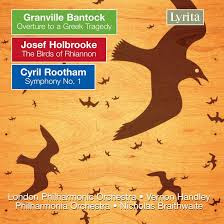The first movement, Adagio-Allegro Ritmico opens with a shimmer on woodwind followed by the main subject. Brass fanfares overlay an urgent message from the strings. Rootham's ability to present a competent woodwind counterpoint is well in evidence as the movement progresses. One of the key features of this composer’s style is his use of brass, both in vigorous contrapuntal writing and in the “chorale” style. Throughout this movement the listener is reminded of elements from Vaughan Williams Wasps Overture and from some passages of the Fourth Symphony. There is a curious point of repose about two-thirds of the way through the movement. A pianissimo roll on the timpani leads to a brass fanfare and marching effects from the side drum. The last chord comes as a slight surprise with a crescendo followed by a diminuendo.
The second movement is underpinned by the tread of a march, Adagio molto (alla marcia). Whether it is pizzicato strings or timpani the regular beat is never far away. On occasion the hearer supplies it for themselves when not stated on one or more instruments. There are two unexpected brass fanfares in this slow movement, interrupting, yet not destroying, the spirit of the long romantic, if slightly unsettling, theme. Once again, the use of a woodwind 'descant' against the strings is in evidence.
Next, is a scherzo, Allegro molto, - yet with features which make this movement quite unique. It opens with a characteristic 'dancing theme' owing much to the English folk-song school. It comes complete with a pizzicato string underpinning. This movement has a greater use of percussion – with xylophone and glockenspiel included. The formal construction involves a slowing down of the pace every so often. The dance theme is abandoned for a kind of romantic, Baxian, musing on strings. It is as if the composer is suffering quite distinctive mood swings - more than one would expect in a scherzo. The listener is conscious of an effective use of brass - almost vocal in its part-writing. The woodwind is used to reiterate the 'dance' tune and some quite involved counterpoint is found in the closing pages. The movement ends quietly.
The Symphony ends with an Allegro con spirito which, as Hutchings describes in his article on Rootham’s music, (Musical Times, January 1938, p.17-22), is a fine piece of “folk-songy or school songy” writing. Brass fanfares introduce the movement which has 'film music' overtones in places. The folksong-like 'big tune' is introduced on strings. The presence of modalism and harmonic parallelism is not far away. There are changes of moods - oboe melodies and echoes on the flutes. Then, a moment of repose followed by a horn theme accompanied by strings and the harp. One is reminded of the last theme of the first movement of the later 6th Symphony of Ralph Vaughan William's. Progress becomes increasingly dissonant, and the brass and snare drum part tend to increase the intensity. Once again, we are presented with the 'Celtic Twilight' on the strings: a "well-wooded backwater" of Rootham’s mind. The 'happy' tune re-emerges complete with counter subjects. The pace slows down slightly, and brass figurations lead to a quiet and certainly not a triumphant finish.
Altogether a fascinating work: certainly, better than many contemporary efforts. Not a major, world-shattering symphony in the sense of Elgar's 2nd or RVW's 4th but one which would raise the rafters were it performed at a BBC Promenade Concert.
The Symphony was given its first broadcast performance on the BBC Home Service on 30 October 1936: Cyril Rootham conducted the BBC Symphony Orchestra.
Vernon Handley and the London
Philharmonic Orchestra recorded the Symphony during January 1979. It was
released by Lyrita Records (SRCS.103) coupled with The Birds
of Rhiannon by Joseph Holbrooke. It was subsequently reissued on CD,
SRCD. 269 in 2007.
The Lyrita recording can be heard on YouTube, here.

No comments:
Post a Comment